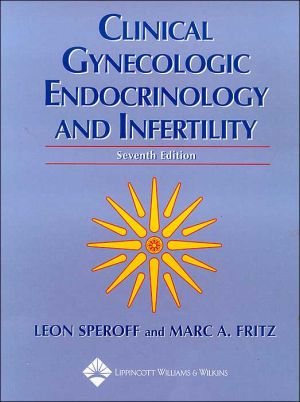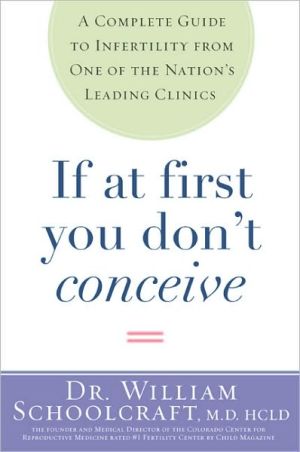How to Get Pregnant
For decades, Dr. Silber's HOW TO GET PREGNANT has been the most popular resource for couples trying to conceive. Now thoroughly revised and updated to include cutting-edge information on all the very latest treatments for infertility, this edition will be the ultimate guide for prospective parents in the 21st century. The comprehensive text explains not only the essential facts of getting pregnant, but also how to solve onceinsurmountable fertility problems. Among the new hightech tests and...
Search in google:
For decades, Dr. Silber's HOW TO GET PREGNANT has been the most popular resource for couples trying to conceive. Now thoroughly revised and updated to include cutting-edge information on all the very latest treatments for infertility, this edition will be the ultimate guide for prospective parents in the 21st century. The comprehensive text explains not only the essential facts of getting pregnant, but also how to solve onceinsurmountable fertility problems. Among the new hightech tests and procedures covered is the revolutionary technique of antral follicle count, which allows women to calculate at any point in their lives how many remaining years of fertility they have and helps them to determine whether to preserve their eggs. For all couples who dream of becoming parents, Dr. Silber's HOW TO GET PREGNANT will be the one and only book they need to address all their concerns about conceiving a healthy child. Library Journal Today, an astounding 25 percent of couples in their mid-thirties are infertile; when they reach 40, that figure rises to 50 percent. Given that many couples are postponing attempts at conceiving until their mid- to late thirties, it's easy to accept urologist Silber's assertion of an epidemic. In this revised and expanded text, first published in 1981, he begins with a review of the female anatomy and the physiology of conception before progressing to mechanisms for "beating your biological clock"; following is coverage of male reproductive physiology and detailed discussions of procedures currently available to help overcome previously unmanageable fertility problems. Compared with two recent publications on dealing with infertility (e.g., Patty Doyle Debano and others' The Conception Chronicles and Janet Jaffe and others' Unsung Lullabies), this book focuses on pertinent physiological, genetic, and technological information instead of psychological support. As such, it should be used in conjunction with Debano's and Jaffe's guides in consumer health collections.-Linda M.G. Katz, Drexel Univ. Health Sciences Libs., Philadelphia Copyright 2005 Reed Business Information.
How to Get Pregnant\ \ By Sherman J. Silber \ Little, Brown and Company\ Copyright © 2005 Dr. Sherman Silber\ All right reserved.\ ISBN: 978-0-316-06650-1 \ \ \ \ Chapter One\ GETTING PREGNANT NATURALLY \ Getting pregnant is not an easy task, but understanding the essential physiology of the process is the best place to start. In this chapter I will describe the arduous journey that sperm must make through the female genitals to reach the egg, as well as the simultaneous adventure of the egg during which it matures to become genetically ready for fertilization, erupts from the ovary, and gets grabbed by the fallopian tube, fertilized, and then hustled along into the womb at exactly the right moment to implant. Failure of the sperm or egg to make an important connection anywhere along this complicated itinerary will prevent pregnancy from occurring.\ A Brief Review of Female Anatomy\ The vagina is an elastic canal, about four to five inches long. At the end of this canal, in the deepest recess of the vagina, is a structure called the cervix, which is the entrance to the womb, or uterus. The uterus is a hard, muscular, pear-shaped structure with a narrow, triangular cavity inside, so small that it would barely hold a teaspoonful of fluid. Yet this is where the fertilized egg must implant itself and grow during the next nine months into a full-size baby. The uterus has a remarkable capacity to expand to allow room for the developing baby, pushing aside and squashing all the other organs of the mother's abdomen. When the baby is ready to be born, the muscles of the uterus contract during labor to squeeze the baby out into the world.\ Far back in the corners of the uterus, on each side, are microscopic canals through which the sperm must squeeze in order to reach the fallopian tube, where it may encounter an unfertilized egg. Once the egg has been fertilized, it will pass through the canal in the opposite direction to reach the uterus. These microscopic canals leading from the uterus into the fallopian tubes are only about one-seventieth of an inch in diameter (the size of a pinpoint). The fallopian tubes are four inches long and hang freely in the abdomen. They widen at the ends into large, flowerlike openings called fimbriae.\ The ovaries are the organs that make the female's eggs and sex hormones. They lie outside of the uterus and fallopian tubes. When an egg is extruded every month from the surface of one of the ovaries (ovulation), it is released freely into the abdominal cavity rather than directly into the tube. The fimbria then comes to life like an octopus tentacle and actively grasps the egg, pulling it into the fallopian tube. The tube swallows the egg, nourishes it before and during fertilization for three days, and then transports it into the uterus.\ While the male produces billions of sperm every week, the female matures only one of her existing eggs for ovulation each month. The ovaries mature and release about four hundred such eggs during the course of a woman's lifetime. Generally, the most fertile eggs are released earlier in life, and of her limited supply of four hundred thousand, about one thousand eggs will die inexorably every month. Thus with advancing years, though a woman may still be able to get pregnant, she is much less fertile than she was in her youth.\ How Do the Egg and the Sperm Reach the Fallopian Tube?\ The journey of the egg, or ovum, through the fallopian tube and finally into the uterus after fertilization is extraordinarily hazardous. The woman's tube is not simply a passive channel through which the egg is transferred; many events must work in precise synchrony for successful pregnancy to occur.\ There are, on the surface of the fimbria, microscopic hairs called cilia, which constantly beat in the direction of the uterus at a fantastically rapid speed and create a kind of conveyor-belt effect for moving the egg into the tube and toward the uterus. The cilia work this magic by digging into the sticky gel, called the cumulus oophorus, that surrounds the egg, and they transport this whole sticky, gooey mass. The egg itself is invisible to the naked eye, but the gel that envelops it is easily visible. If this sticky substance were not present, and the egg were placed bare upon the surface of the fimbria, the beating of the cilia would never move the egg along. The cilia are only able to dig in and transport the egg with this sticky, gooey material encasing it.\ The process of grasping the egg and moving it into the interior of the tube requires only about fifteen to twenty seconds. Once the egg is safely within the tube, it is transported quickly toward the narrower region of the tube, the ampullary-isthmic junction, located two-thirds of the way toward the uterus. Here, the egg must wait for a successful sperm coming from the opposite direction to fight its way into the egg's tough outer membrane, the zona pellucida, score a direct hit, and thereby establish pregnancy. While the egg is held in this location by the tight resistance of the narrow region of the tube, the much tinier sperm nonetheless must struggle through this area of resistance to arrive from the opposite direction. Once it is fertilized, the egg must be nourished for several days in the ampulla of the tube before it can be allowed to pass into the uterus. If it is transferred into the uterus too soon, it will not be ready to implant, and it will die. If the transfer of the egg into the uterus is delayed too long, a tubal, or ectopic, pregnancy will occur (the fertilized egg will implant in the tube rather than the womb). Once the egg has been allowed to develop in the tube for three or more days, the isthmus suddenly opens up and the early embryo passes quickly into the uterus. Because the journey of the egg from the ovary to the site of fertilization, its nourishment in the tube, and the precise synchrony of the continuation of its journey into the womb are so intricate, problems with this egg and embryo transport process are frequently responsible for female infertility.\ If the egg is not penetrated by sperm soon after ovulation, it becomes overripe and dies. After the egg is released from the ovary, it is only capable of fertilization for about twelve, or possibly at most twenty-four, hours. The likelihood of intercourse taking place during such a specific interval in any month is rather slight. So nature must provide some mechanism for providing a continuous flow of healthy sperm to the site of fertilization. That way, if intercourse is perhaps one or two days off schedule, some sperm can still arrive at the site of fertilization at the right time. For this reason, complicated barriers to sperm transport are necessary.\ The success of IVF demonstrates that if eggs can be recovered at precisely the right time, they can be fertilized in the laboratory with only a small number of sperm. Then the complicated barrier mechanisms provided by nature to allow a slow, continuing flow of a small number of sperm at any moment is not necessary and the large numbers of sperm normally required for fertilization through intercourse are not needed.\ Ejaculation into the Vagina\ Most of the spermatozoa in the ejaculate are contained in the very first portion of fluid that squirts out of the penis and enters the vagina. The remaining squirts usually contain very little sperm. Thus, at the first moment of ejaculation the female's cervix (the opening leading into her uterus) is bathed by a high concentration of sperm. Within just a few minutes after ejaculation, sperm begin to invade a very thick fluid (called cervical mucus) that is pouring out of the cervix. The sperm must be able to invade the cervix via the cervical mucus by virtue of their own swimming ability. Nothing about the sexual act will help those sperm get into the cervix. They simply have to swim into the mucus on their own, and this requires a great deal of coordinated, cooperative activity on their part.\ Ejaculation is a challenging moment for the sperm, as the vagina presents a very harsh, acidic environment, which would normally immobilize them quickly. The alkalinity of the semen (the fluid that contains the sperm), as well as the alkalinity of the cervical mucus, allows the sperm to survive in this difficult vaginal milieu. Any acidity at all quickly kills sperm.\ Yet even the semen is a potentially dangerous milieu for the sperm; any sperm that remain in the semen for more than two hours are likely to deteriorate. In order to survive long enough to get to the egg and fertilize it, the sperm must gain rapid access to the cervical mucus. Any sperm that have not penetrated the cervical mucus within a half hour after orgasm will not be able to do so later on, because by then they will have lost their ability to swim into the more friendly environment of the cervix.\ Sperm Invasion\ Spermatozoa can be seen invading the cervical mucus within seconds after ejaculation, but most will not make it. Of some 200 million sperm deposited into the vagina near the cervix in a typical ejaculation, only 100,000 ever get into the womb. Thus, over 99.9 percent of the sperm never have a chance of getting beyond the vagina.\ Once the sperm enter the canal of the cervix, they are capable of fertilizing the egg for as long as forty-eight to seventy-two hours, though they may actually live for up to six days. Remember, since the egg is only fertilizable for about twelve hours after ovulation, it is important to have a continuing flow of sperm across the tube so that whenever the egg appears, there will be sperm available. In this sense, the canal of the cervix can be looked upon as a receptacle through which platoons of spermatozoa migrate and in which some are detained in order to ensure a continuous supply of smaller numbers, over a prolonged period of time, to the deeper recesses of the female where fertilization takes place. Of course, these delaying mechanisms can do more harm than good in infertile couples if events do not allow the invasion of sperm to be mounted successfully.\ To understand how this invasion of sperm gets launched effectively, we must first understand the remarkable liquid that covers the opening of the womb-the cervical mucus. The cervical mucus presents a very effective barrier to bacteria and thus protects the womb against infection. It is a selective filter, which favors normally active sperm and excludes other objects (including poor-quality sperm) from access. But it doesn't even permit access to normal sperm except during a specific period at midcycle when ovulation is imminent and fertilization is possible. Cervical mucus resembles a thick, clear liquid that can be poured from one container into another. However, in a technical sense, it is not a liquid. As it is being poured, it can actually be cut with scissors; therefore, although it seems to behave as a thick liquid, it also has the characteristics of a very pliable, transparent plastic.\ Cervical mucus is absent or very scanty during most of the monthly cycle, gradually becoming more abundant around the middle of the cycle, under the influence of increasing estrogen levels, when ovulation is about to occur. Just prior to ovulation it becomes almost optically clear, although it is translucent at other times. At the moment when fertilization is possible, near the time of ovulation, the mucus can be stretched out into a very thin strand; at other times in the cycle it is more sticky, and if stretched it will break. All of these changes in the cervical mucus, which occur around the time prior to ovulation, are designed to help sperm gain access to the uterus. The more liquidlike character, the greater transparency, and the greater stretchability (called Spinnbarkheit) are all characteristics that favor the successful invasion of an army of sperm. When the mucus is sticky and thick, not as abundant, and translucent rather than transparent, it is difficult if not impossible for any sperm to gain access.\ Microscopically, the cervical mucus consists of a dense mesh that, during most of the monthly cycle, represents a solid barrier to invasion. Just prior to ovulation, under the effect of the female hormone estrogen, mucus production rises tenfold, and the water content of the mucus increases. The otherwise impenetrable mesh opens up and allows a successful invasion of sperm. When semen first reaches the cervical mucus after ejaculation, a clear barrier line can be seen separating the two different fluids. Semen does not "mix" with cervical mucus. Soon, however, phalanges of sperm begin to penetrate the mucus, forming branching structures that invade it.\ Observing the sperm's penetration of the cervical mucus under the microscope is an exciting event. Sperm at first seem to bounce against the cervical mucus without any evidence that they will ever be able to gain access. Their movements while in the ejaculate are haphazard and not specifically aimed toward the mucus. However, within a matter of minutes, one or two spermatozoa begin to make an indentation in the line separating the cervical mucus from the ejaculate. Once one sperm has been able to initiate the penetration of the mucus, other sperm then quickly follow at that same point of entry. Sperm then continue to invade the cervical mucus at that point much like a single-file line of army ants. Only one or two spermatozoa at a time can pass through this entrance.\ The sperm swim in a straightforward direction along parallel rows of the invisible microscopic molecular structure of the mucus. Once this invasion of the cervical mucus has been established, sperm can reach the fallopian tubes in about thirty minutes.\ Pregnancy would not be likely if all the sperm got into the fallopian tubes at one time, because they would soon pass on into the abdominal cavity, and not be available to fertilize the egg except during a very brief, lucky interval. If they were not lucky enough to pass through the fallopian tube at exactly the moment of ovulation (or within twelve hours of ovulation), they would be long gone by the time the egg arrived. Thus, nature had to invent some mechanism for allowing a continuous entry to the site of fertilization by a smaller number of sperm. To accomplish this, the cervix and the cervical mucus act as a reservoir from which spermatozoa are slowly released into the uterus and up to the fallopian tubes over a period of several days.\ Capacitation of Sperm\ During the course of their odyssey toward the site of fertilization, the sperm undergo capacitation, a process that was not fully understood before the advent of IVF. It used to be thought that unless sperm resided for a certain period of time outside the male reproductive tract and in the specific fluids of the female reproductive tract, they would not be capable of fertilization, even though in every other respect they looked normal. It was thought that this process of capacitation could occur only in the fluids of the female reproductive tract while the sperm migrated toward the egg. However, in vitro fertilization has demonstrated that capacitation of sperm (once considered one of the greatest problems in successfully achieving test-tube babies) can occur in relatively simple, nonspecific fluids available in any laboratory.\ All that is necessary to start the capacitation process going is to remove the sperm from the semen by "washing" it. Removing the sperm from semen and placing them in any laboratory "culture media" fluid results in a dramatic tripling of their swimming velocity, so that even though they are mere human sperm, they begin to swim more like the sperm of horses or bulls. Thus, sperm seem to have a natural tendency toward developing capacitation for fertilization on their own and simply require a period of several hours outside the semen. In nature this happens when they leave the semen and enter the cervical mucus. In the IVF laboratory it happens when sperm are separated from the semen by virtually any washing technique.\ Ovulation\ Before egg and sperm can ever meet up in the fallopian tube, the egg must be matured and extruded from the ovary in a process called ovulation. Since many women who seem unable to have children owe their problems to a disturbance in ovulation, and since part of the IVF procedure involves stimulating the ovaries to prepare many eggs for fertilization, we should understand how the repeatable, monthly series of changes leading to ovulation occurs naturally in the ovary. Later we will unravel the hormonal events of the menstrual cycle, which regulate the clocklike orderliness of ovulation.\ All of the hormonal events taking place during the month between menstrual periods are directed at preparing the egg to be genetically ready for fertilization, and preparing the uterus (womb) and the cervix for the moment of ovulation, so that the sperm and the egg have the best opportunity for joining up to form an embryo, which can then implant in a properly prepared uterus and result in successful pregnancy.\ (Continues...)\ \ \ \ \ Excerpted from How to Get Pregnant by Sherman J. Silber Copyright © 2005 by Dr. Sherman Silber. Excerpted by permission.\ All rights reserved. No part of this excerpt may be reproduced or reprinted without permission in writing from the publisher.\ Excerpts are provided by Dial-A-Book Inc. solely for the personal use of visitors to this web site. \ \
\ Library JournalToday, an astounding 25 percent of couples in their mid-thirties are infertile; when they reach 40, that figure rises to 50 percent. Given that many couples are postponing attempts at conceiving until their mid- to late thirties, it's easy to accept urologist Silber's assertion of an epidemic. In this revised and expanded text, first published in 1981, he begins with a review of the female anatomy and the physiology of conception before progressing to mechanisms for "beating your biological clock"; following is coverage of male reproductive physiology and detailed discussions of procedures currently available to help overcome previously unmanageable fertility problems. Compared with two recent publications on dealing with infertility (e.g., Patty Doyle Debano and others' The Conception Chronicles and Janet Jaffe and others' Unsung Lullabies), this book focuses on pertinent physiological, genetic, and technological information instead of psychological support. As such, it should be used in conjunction with Debano's and Jaffe's guides in consumer health collections.-Linda M.G. Katz, Drexel Univ. Health Sciences Libs., Philadelphia Copyright 2005 Reed Business Information.\ \








